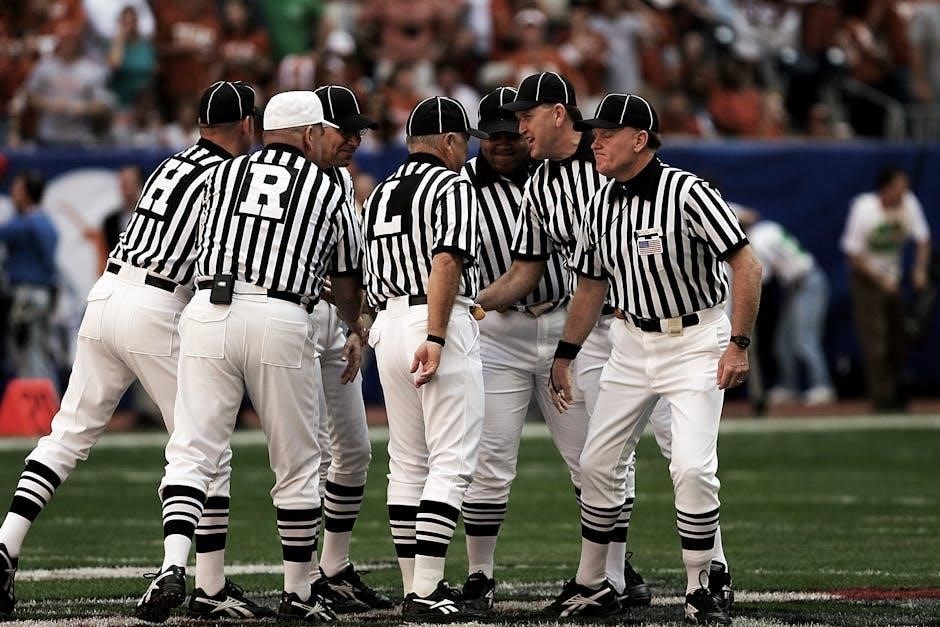Five Crowns is a dynamic rummy-style card game featuring a unique five-suit deck and progressive wild cards․ Players aim to form runs and books while minimizing their score over 11 rounds, blending luck and strategy in a thrilling experience․
Overview of the Game
Five Crowns is a rummy-style card game with a unique five-suit deck, including stars, hearts, clubs, spades, and diamonds․ Each suit has cards from 3 to 10, plus face cards․ The game features 11 rounds, with the number of cards dealt increasing each round․ Wild cards progress from 3s to Kings, adding strategy․ Players form runs and books to minimize their score, with the lowest score after 11 rounds winning․ Jokers are always wild, and unused cards penalize players; Ideal for 2 to 7 players․
Importance of Understanding the Rules
Mastering the rules of Five Crowns is essential for strategic play and fair competition․ Understanding wild card progression, scoring, and valid runs/books ensures players can minimize penalties and maximize their chances of winning․ Knowing how to form melds, manage wild cards, and navigate the game’s progression is crucial for success․ Without a clear grasp of the rules, players risk unnecessary penalties and missed opportunities, making the game less enjoyable and more challenging to win․

Deck Composition
The Five Crowns deck consists of two 58-card decks, each with five suits: stars, hearts, clubs, spades, and diamonds․ Each suit contains cards from 3 to King․
Number of Cards and Decks
Five Crowns is played with two 58-card decks, totaling 116 cards․ Each deck includes five suits (stars, hearts, clubs, spades, diamonds), with cards ranging from 3 to King․ Each deck also contains three Jokers, adding six Jokers in total․ This unique composition allows for dynamic gameplay and strategic depth, accommodating up to seven players․ The dual-deck system ensures a wide variety of cards, enhancing the game’s complexity and fun factor for all participants․
Suits and Card Values
Five Crowns features five unique suits: stars, hearts, clubs, spades, and diamonds․ Each suit contains cards numbered from 3 to 10, followed by Jack, Queen, and King․ Number cards hold face value, while Jacks, Queens, and Kings are worth 11, 12, and 13 points, respectively․ Jokers and wild cards carry higher point values, with Jokers worth 50 points and wild cards 20 points․ This structure adds depth to scoring and strategy, making card management crucial for victory․
Wild Cards and Jokers
In Five Crowns, wild cards and Jokers add strategic depth․ The wild card changes each round, progressing from 3s to Kings, and is determined by the number of cards dealt․ Jokers remain wild throughout the game․ Wild cards are worth 20 points, while Jokers carry a hefty 50 points․ Players can use these cards to complete runs or books, but their high point values make them risky to hold; Managing wild cards effectively is key to minimizing penalties and achieving a low score․
Setup and Preparation
Five Crowns requires 2-7 players and uses two 58-card decks․ The dealer shuffles and distributes cards, starting with the player to their left, increasing the card count each round․
Number of Players
Five Crowns is designed for 2 to 7 players, making it ideal for small to medium-sized groups․ The game can also accommodate up to 14 players by combining two decks, allowing larger gatherings to join in the fun․ The number of players directly influences the setup and card distribution, ensuring dynamic gameplay regardless of group size․ The dealer position rotates after each round, adding a fair and balanced element to the game’s progression․
Dealing the Cards
The game begins with the dealer shuffling both decks and distributing cards clockwise, starting with the player to their left․ Each round starts with three cards per player, increasing by one each round until the final round, where 13 cards are dealt․ The number of cards dealt matches the round number, with the wild card corresponding to the round’s card count․ After dealing, remaining cards form a draw pile, with the top card turned over to start the discard pile, setting the stage for gameplay․
Initial Setup and Dealer Rotation
The game begins with two 58-card decks combined and thoroughly shuffled․ The dealer, chosen at the start, rotates clockwise after each round․ Initial setup involves dealing cards starting with the player to the dealer’s left․ The number of cards dealt increases each round, from three in the first round to thirteen in the eleventh․ The dealer’s role progresses, ensuring each player takes turns dealing, while the wild card changes with each round, enhancing strategic depth and fairness in gameplay․

Objective of the Game
The goal is to achieve the lowest score by forming valid runs and books, strategically using wild cards, and minimizing leftover cards after 11 rounds of play․
Goal of the Game
The primary objective in Five Crowns is to be the player with the lowest score after completing all eleven hands․ This is achieved by forming runs or books, effectively using wild cards, and ensuring minimal points from unused cards at the end of each round․ Players must strategically discard and collect cards to achieve this goal, balancing risk and reward as the game progresses through its unique structure․
Winning Conditions
The game concludes after eleven hands, with the player having the lowest cumulative score declared the winner․ Points are calculated based on unused cards, with Jokers and wild cards carrying high values․ Successfully forming runs or books minimizes penalties, while strategic use of wild cards can significantly impact the final score․ The player who consistently manages their cards effectively and adapts to the changing wild card in each round emerges victorious, showcasing a blend of skill and adaptability․

Gameplay Mechanics
Five Crowns involves 11 rounds, with each round increasing the number of cards dealt․ Players draw, discard, and form runs or books, using wild cards strategically to minimize penalties and achieve the lowest score․
Turn Structure
A player’s turn begins by drawing a card from the deck or picking up the top card from the discard pile․ After drawing, the player must discard one card to the discard pile․ The turn ends after discarding․ Players can only lay down cards during their turn if they have already met the game’s melding requirements․ Strategy focuses on optimizing draws and discards to form valid runs or books while minimizing penalty points․ Proper turn structure ensures smooth gameplay progression․
Drawing and Discarding Cards
Players start their turn by either drawing the top card from the deck or picking up the discard pile’s top card․ After drawing, a card must be discarded to the pile․ Discarding is mandatory and ends the turn․ Strategy involves choosing between deck and discard pile to optimize hand improvement․ Players must discard strategically to avoid holding high-value cards at the end, as these contribute to penalties․ Efficient drawing and discarding are crucial for successful gameplay;
Forming Runs and Books
A run consists of three or more sequential cards of the same suit, while a book is three or more cards of the same rank across different suits․ Wild cards and Jokers can substitute for missing cards in both runs and books․ Each run or book must include at least one natural card, with no limit on the number of wild cards used․ Strategy revolves around efficiently forming these combinations to minimize leftover cards and reduce penalties at the end of each round․

Melding and Laying Down Cards
Players can lay down cards in runs or books during their turn or when “going out․” Once a player goes out, others get one final turn to lay down cards․
What Constitutes a Meld
A meld in Five Crowns consists of either a run or a book․ A run is three or more sequential cards of the same suit, while a book is three cards of the same rank․ Wild cards can substitute for missing cards in either a run or a book․ Multiple wild cards can be used consecutively, and they can be placed next to each other․ Each meld must contain at least one natural card, ensuring the integrity of the combination․
Rules for Laying Down Cards
Players can lay down cards during their turn or after another player has gone out․ To lay down, all cards must form valid runs or books․ Each meld must include at least one natural card, with no limit on wild cards․ Once laid down, cards cannot be altered․ Players cannot add to others’ melds․ The discard pile’s top card can be used strategically, but laying down requires careful planning to maximize points and minimize penalties․
Going Out
Going out occurs when a player can organize all their cards into valid runs or books, discarding one unused card․ This can be done after drawing or picking up from the discard pile․ The discarded card must fit into the laid-down melds․ Once a player goes out, others get one final turn to lay down their cards․ Going out earns zero points, while others score based on leftover cards․ It’s a strategic move to minimize penalties and secure a low score․

Scoring System
Card values determine points: numbered cards match their value, Jacks are 11, Queens 12, Kings 13, Jokers 50, and wild cards 20․ Lowest score wins after 11 rounds․
Card Values and Points
In Five Crowns, numbered cards score their face value, Jacks 11, Queens 12, and Kings 13․ Jokers are worth 50 points, while wild cards score 20․ The player who goes out earns zero points, while others tally points for unused cards․ Strategic use of wild cards and Jokers is crucial to minimize penalties and achieve the lowest score․ Accurate tracking ensures fair play, making every card count toward victory․
Scoring for Runs and Books
Scoring in Five Crowns rewards strategic card play․ Runs and books must include at least one natural card, with wild cards and Jokers as supplements․ Numbered cards score face value, Jacks 11, Queens 12, Kings 13, Jokers 50, and wild cards 20․ The player who goes out earns zero points, while others tally points for unused cards․ Efficient use of wild cards minimizes penalties, emphasizing strategic planning and card management to achieve the lowest score․
Penalties for Unused Cards
Unused cards incur penalties, motivating players to minimize leftovers․ Numbered cards count as their face value, Jacks 11, Queens 12, Kings 13, Jokers 50, and wild cards 20․ Strategic discarding and efficient card play are crucial to avoid high penalties․ Players must balance forming runs and books with discarding wisely to keep their score low, ensuring careful planning and timely moves to minimize end-of-round penalties․

Game Structure
Five Crowns consists of 11 rounds, with the number of cards dealt increasing each round․ The wild card progresses from 3s to Kings, adding strategic depth․
Number of Rounds
The game consists of 11 rounds, with each round increasing in complexity․ Starting with 3 cards dealt in the first round, the number of cards increases by one each round, reaching 13 cards in the final round․ This progression challenges players to adapt their strategies as the game advances, ensuring a dynamic and engaging experience from start to finish․
Progression of Wild Cards
In Five Crowns, wild cards evolve with each round, adding a strategic layer․ Starting with 3s as wild in the first round, the wild card progresses to 4s, 5s, and so on, until Kings become wild in the final round․ Jokers remain wild throughout, offering consistent flexibility․ This progression requires players to adapt their tactics, as the value and utility of wild cards change, influencing how they form runs and books․
Final Round and Winner Determination
The final round of Five Crowns is the 11th hand, where Kings serve as the wild cards, adding a last layer of strategy․ After all players have taken their final turns, scores are tallied based on unused cards․ The player with the lowest total points is declared the winner․ If tied, the player who went out the most times may break the tie, ensuring a clear conclusion to the game․

Strategy and Tips
Mastering Five Crowns requires balancing flexibility with strategic planning․ Focus on managing wild cards effectively and staying adaptable, especially in the endgame, to outmaneuver opponents and secure victory․
General Strategies
In Five Crowns, flexibility is key to success․ Focus on maintaining multiple play options by keeping a balanced hand․ Prioritize forming runs and books early, while strategically using wild cards to complete sets․ Monitor the discard pile to anticipate opponents’ moves and adjust your strategy accordingly․ Adaptability, especially with changing wild cards each round, is crucial for minimizing points and outperforming others in the long run․
Wild Card Management
Effectively managing wild cards is essential in Five Crowns․ Use them strategically to complete runs or books without over-relying on them․ Remember, wild cards have high point values if unused, so prioritize incorporating them into melds․ Keep track of the current wild card for each round and plan accordingly; If holding multiple wilds, consider discarding extras to minimize penalties, but avoid giving opponents advantageous discards․ Balancing wild card usage is vital for maintaining a low score․
Endgame Tactics
As the game progresses, focus on minimizing points by strategically arranging cards into runs or books before others․ Aim to go out early to earn zero points for that round․ Manage high-value cards like Jokers and Kings wisely, as they carry hefty penalties if unused․ Stay flexible, as the game’s outcome can shift dramatically in later rounds․ The final round, where Kings are wild, offers last-chance opportunities to overhaul your position, making adaptability crucial for victory․

Variations and Special Rules
- Junior Version: Simplified for younger players, focusing on matching cards by color or number to win treasure chips․
- Solitaire Play: A single-player mode where players manage 11 hands, aiming to close all by strategically placing cards․
- House Rules: Custom modifications, like tiebreakers or wildcard strategies, can enhance or simplify gameplay for different player preferences․
Junior Version
The Junior Version of Five Crowns is a kid-friendly adaptation designed for ages 5 to adult․ It simplifies the classic game, focusing on matching cards by color or number to win treasure chips․ Players aim to match all five cards in their hand, with the rotating wild card adding excitement․ This version is ideal for teaching younger players strategy and card game basics while keeping the gameplay fun and engaging for the whole family․
Solitaire Play
In Solitaire Five Crowns, the objective is to close out all 11 hands․ Arrange 11 piles, with the first containing 3 cards, the second 4, and so on, up to 13 cards․ Each pile represents a hand, with wild cards corresponding to the number of cards dealt․ Draw one card at a time, placing it in the hand where it offers the most advantage․ Discard one card from that hand, which cannot be reused․ Hands are turned over when they can go out․ The game ends when all hands are closed (win) or the deck is exhausted (lose);
House Rules and Modifications
House rules can enhance Five Crowns by adding personal twists․ A popular modification is using a tiebreaker where the player who went out the most wins․ Some groups allow combining two decks for up to 14 players․ Others introduce bonus points for specific card combinations․ These modifications keep the game fresh and tailored to players’ preferences․ Experimental rules can be agreed upon before starting, ensuring everyone is on board with the changes․
Five Crowns is a captivating card game that combines strategy and fun, offering a unique twist on traditional rummy․ Its dynamic gameplay and progressive wild cards ensure endless entertainment for all players․
Five Crowns is a rummy-style card game with a unique five-suit deck, offering a blend of strategy and luck․ The game progresses through 11 rounds, with the number of cards dealt increasing each round․ Players aim to form runs and books, with wild cards adding a dynamic twist․ The game’s scoring system penalizes unused cards, emphasizing efficient play․ Understanding the rules and mastering wild card strategy are key to success in this engaging and challenging card game․
Encouragement to Play
Five Crowns offers a unique and engaging card game experience, perfect for both casual and competitive players․ With its dynamic wild card system and strategic depth, it challenges and entertains․ The game’s flexibility accommodates 2 to 7 players, making it ideal for family gatherings or social events․ Whether you’re a seasoned pro or a newcomer, Five Crowns provides endless fun and opportunities to refine your skills․ Dive in and discover why this game is a favorite among card enthusiasts of all ages!

Additional Resources
Explore the official Five Crowns rulebook, online tutorials, and strategy guides for deeper insights․ Community forums and video guides also offer tips and variations to enhance your gameplay experience․
Official Rulebook
The official Five Crowns rulebook provides a comprehensive guide to the game, detailing setup, dealing, scoring, and special rules․ It includes instructions for both standard and solitaire play, ensuring clarity for new and experienced players alike․ The rulebook outlines the progressive wild card system, melding rules, and scoring mechanics, making it an essential resource for understanding the game․ Available as a downloadable PDF, it offers a convenient reference for learning and mastering Five Crowns․
Online Tutorials and Guides
Online tutorials and guides for Five Crowns provide step-by-step instructions and video demonstrations to help players master the game․ These resources cover the basics, such as understanding the rules and setup, as well as advanced strategies for managing wild cards and forming runs and books․ Many guides also include tips for solitaire play and advice for improving your chances of winning․ They are ideal for both new players and those looking to refine their skills and explore variations of the game․
